Transmoto – 2013 Beta RR300 vs 2013 KTM 300EXC + 2013 Beta RR350 vs 2013 Husaberg FE350
 iKapture Images
iKapture Images
This article originally appeared in Transmoto’s March Issue. To pick up a print or digital copy, click here.
Can Beta’s all-new 2013 RR300 rain on KTM’s two-stroke enduro bike parade? We assess the Italian’s chances against the market-leading 300EXC, and then compare Beta’s revamped 2013 RR350 four-stroke with Husaberg’s FE350.
The 300cc Two-Strokes
2013 Beta RR300 – $11,290
The Italian company’s engineers started with a blank canvas, dropping an all-new two-stroke powerplant into a revised chassis, suspension and bodywork package for 2013. But can it really match KTM’s 300EXC crowd-pleaser?

2013 KTM 300EXC – $11,995
After a major overhaul for 2012, the biggest-selling two-stroke in Australia gets a revised triple clamp offset, black-anodised spokes and fresh graphics for 2013. So, has it stood still while the opposition’s been on the move?
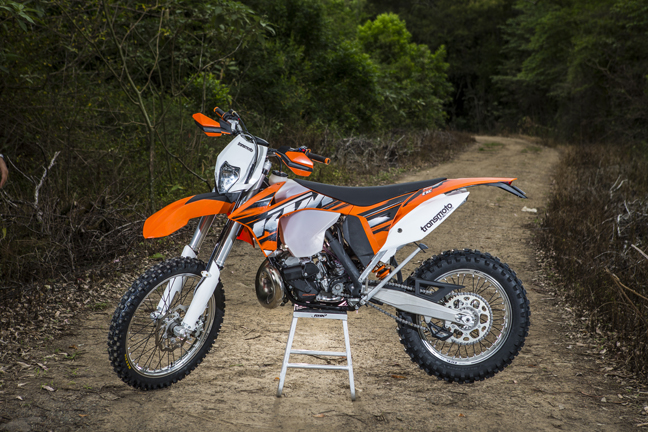
For years, KTM’s CEO, Stefan Pierer, voiced concerns about the worldwide trend away from two-stroke dirt bikes, citing the risk it posed to participation in the sport. And at the height of the four-stroke ‘takeover’ in 2004, he vowed that KTM would continue developing its two-stroke models; to ensure these low-maintenance machines remained competitive and available to the masses at affordable prices. The decision paid huge dividends and, in the years since, KTM’s cutting-edge two-bangers have helped the Austrian company steal large chunks of market share. Spearheaded by the 300EXC, two-strokes even became KTM’s biggest-selling models in several countries, so it’s no coincidence that the revamped 2013 Husaberg range – which rolls off KTM’s production line in Austria – includes a quartet of two-strokes.
But KTM/Husaberg hasn’t been the only European manufacturer to capitalise on the resurgent demand for two-strokes. Gas Gas, TM and Husqvarna continue to offer competitive bikes, even though their two-strokes haven’t always been the focal point of upgrade programs in recent years. And in the past 12 months, Jotagas, Sherco and Beta have all announced the imminent release of their first ever two-stroke enduro models.
Of the new entrants, the Beta is the first to actually materialise. And it couldn’t have come at a better time for the family-owned Italian manufacturer, which has only been producing four-stroke enduro models since 2006. According to Beta Australia’s Gary Grealy, the new two-strokes are generating plenty of interest. “We’ve finally moved past the ‘It’s a what?’ and ‘Where are Betas made?’ questions,” reveals Grealy. “We’re now seeing prior knowledge about the brand and we’re fielding specific questions about the bikes and how they compare to the KTMs.”
Of course, having won 13 world trials championships, Beta is hardly new to two-stroke technology. But the 2013-model RR250 and 300 are the company’s first foray into the much more lucrative two-stroke enduro bike segment. And with quality componentry and aggressive pricing, the Italians have already got KTM/Husaberg squarely in their sights.
But how do these all-new Beta two-strokes compare with the market-leading KTMs to ride and race? To get a gauge on that, we convinced Gary Grealy to part with the only 2013-model RR300 in the country for a few days so we could put it back-to-back with KTM’s 300EXC.
Inside The Upgrades
With a major overhaul for 2012, the KTM 300EXC only gets a few tweaks for 2013. The triple clamp offset is pulled back to 20mm, plus there’s new black-anodised spokes and fresh graphics. But that’s it. And without the radical new bodywork that appeared on KTM’s 2013 SX and SX-F models, the 2013 EXCs are now easier to distinguish from their motocross brethren. The Betas, on the other hand, cop a host of upgrades and refinements for 2013. Of course, when we say upgrades, we’re referring to the chassis, suspension and bodywork upgrades the four-stroke Betas received for 2013, and into which Beta’s brand new two-stroke engine has now been planted.
Last year, we said the Betas appeared over-engineered; that their designers had pursued a “reliability at all costs” mantra and erred on the side of caution when they specced the bikes’ componentry. Frames, hubs, swingarm and wheels were all very beefy and, as a result, the four-stroke Betas were 11kg heavier than their KTM counterparts. Which is a lot. So it’s good to see that the thrust of Beta’s 2013 upgrades is about refining components to save weight. For 2013, the entire Beta range gets revisions to frame, subframe, swingarm, wheels, hubs and bodywork, all of which adds up to a saving of 5kg. Just 3.3kg now separates the Beta and KTM 300cc two-strokes on our digital scales (and the 11kg differential between the 350cc four-strokes is now closer to 6kg).
Componentry
If you spend half an hour tinkering with these two 300s, you soon realise just how much thought has been put into their design. Aside from the quality componentry you’ll find across the board, there’s a real coherence in the way it’s all put together, and fastener commonality makes them a cinch to work on. Both machines boast fantastic tool-free access to their air filters and each bike’s fuel tank can be removed with just two or three bolts. Both run electric starters, Brembo hydraulic clutches (with OTF lever adjustment), polished alloy hubs, wave brake discs, rubber-mounted headlights, adjustable power-valves, digital instrumentation, extended frame guards, subframe grab-handles, star clickers in the fork caps for tool-free rebound adjustment and quality alloy sidestands.
The Beta also stands out for its billet triple clamps, new glossy red frame paint, black-anosdised rims, quick-release seat fastener, forged brake and gearshift pedals, updated digi speedo (now with more functions and a better display), and its Beta-branded FMF exhaust system – yep, expansion chamber and muffler. In other words, if the KTM is ‘ready to race’, the Beta is sure is, too.
We’d like to see handguards as standard equipment on the Beta (aftermarket units were fitted for our test) but, then again, the RR300 comes with a hard-plastic bashplate while the KTM doesn’t. The only other shortcoming with the Beta is that its radiator shroud graphics still scuff up quickly, and the plastic locating lugs at the bottom of the headlight assembly seem to break easily. Oh, and it’s about time that Nissin fitted an OTF adjuster to their front brake lever, isn’t it?
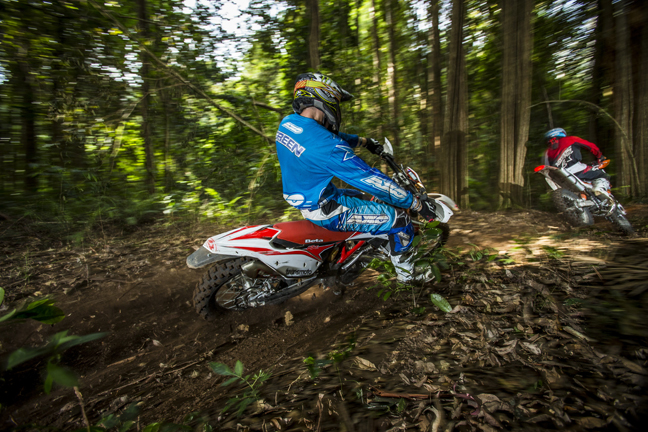
The Ergos
No one ever accused the Italians of lacking style, and the 2013 Betas are certainly good-looking creatures. Changes to the tank, seat and subframe give the bikes a noticeably different silhouette, and the ‘shark-gill’ look of last year’s radiator shrouds is replaced by cutaway sections to improve airflow.
Lower, narrower, flatter, firmer, grippier – they’re the first things that come to mind about the 2013 Beta’s seat, which is tiny. The seat height itself hasn’t been lowered, but because it’s now flatter and barely ramps up where it meets the new fuel tank (which is mounted noticeably lower relative to the oth feet flat on the ground when sitting on the very front of the seat. That’s a real bonus for short guys, and comes in handy for all riders in tech terrain, mud and hillclimbs, but it does take a little getting used to at first. The racier seat and narrower ergos definitely make it easier to get yourself forward in the Beta’s saddle to load the front tyre, and there’s heaps of legroom under the bars when you’re cranked over in deep ruts.
But when Beta engineers redesigned the fuel tank for 2013, they could (and should) have taken the opportunity to add capacity. Sure, an interchangeable tank across the whole Bata range is lovely for the spare parts department, but with the same 8 litres of juice as the four-stroke models, the two-stroke Betas will struggle to make 100km on a tank. That won’t bother race-oriented guys, but it’ll leave a lot of trailriders feeling short-changed. Speaking of practicality, a clear tank would have made life easier than the black plastic unit Beta has persisted with – both for determining the fuel level during a ride and to avoid overfilling the thing in the shed.
By comparison, the Kato cockpit is noticeably taller. Its seat (even when new) is much softer than the Beta’s and ramps up at its junction with the tank – much like most enduro bikes do. Sinking down into the Kato seat can be a good thing in that it helps keep your arse planted firmly, but it can also create a nasty case of monkey-butt after a few hours in the saddle, and racers will immediately look to fit a more functional firmer seat foam.
Both machines are similarly slim through the girth, but the Beta’s footpegs are a little wider apart. That’s partly because both the engine cases and frame are wider on the Beta, but also because of the Italian brand’s trials heritage where wide-set pegs are customary – they help with balance and direction changing through peg weighting.
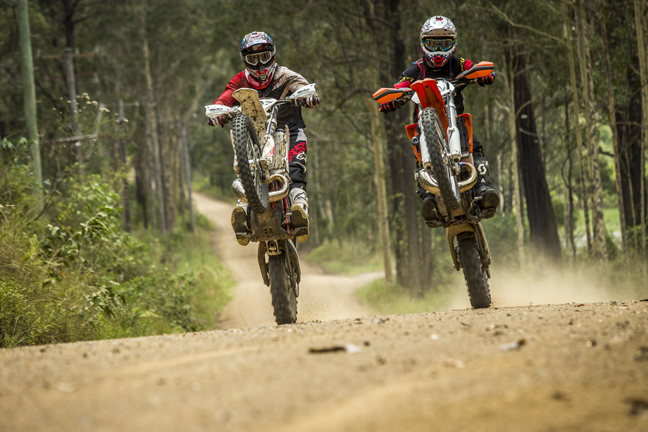
The Powerplants
KTM’s 300EXC has set the standard in its class for several years now in terms of how broad and user-friendly its power is, but the Kato might finally have met its match. There’s no doubt that Beta’s engineers first-up enduro-specific two-stroke engine is a damn good one. It runs the same 72 x 72mm bore and stroke as the KTM and it delivers a similar sort of broad, linear and predictable power. In fact, these two-strokes are so torquey, they put their power to the ground almost as effectively as four-strokes.
At low revs, the Beta is an absolute standout and produces even more torque than the KTM. This engine delivers a responsive, seamless and predictable surge of grunt right through the rev range, and rarely needs any assistance with the clutch. And its FMF exhaust (made specifically for Beta) creates a meaty-sounding note. It’s a versatile power curve because you can dial it on smoothly to get the rear wheel hooking up in slick terrain, or crack the throttle to explode out of loamy turns. And when it comes to firing the bikes into life, the Beta is a cross-country holeshot machine. The ingenious under-engine electric starter is the most effective unit on the market. Unlike the electric legs on several two-strokes, the Beta’s starter engages immediately – no screeching, no rattling, no fuss. One brief stab on the button and the bike starts.
KTM’s 300EXC still has plenty of useable power off the bottom, but it starts to come alive and boogie through the mid-range and comes onto the pipe a little more aggressively than the Beta. You wouldn’t call it a ‘hit’, but the Kato’s transition from bottom to mid isn’t quite as silky smooth as the Beta’s.
When we speak about each engine’s power character here, we’re referring to the power they each generate with the standard power-valve settings – because both bikes offer a wide range of adjustment via an externally adjustable power-valve screw or, in the KTM’s case, the combination of three power-valve springs and an adjuster screw. On the face of it, that’d suggest the Beta doesn’t have the same degree of tunability as the KTM, but that’s not the case. The six turns of preload adjustment on the RR300’s power-valve transforms the delivery from trials-bike gentle to motocross-bike aggro, and everywhere in between. It’s simpler than the KTM’s system and something more riders will be inclined to play with. That said, it would certainly make life easier if the Beta’s adjuster screw was marked. It’d save you having to turn the thing all the way in or out to determine the preload setting. The only other criticism of the Beta’s powerplant is that its transmission isn’t quite as slick or positive as the KTM’s. You need move the RR’s longer-than-average gearshift pedal further to properly engage gears and avoid false neutrals.
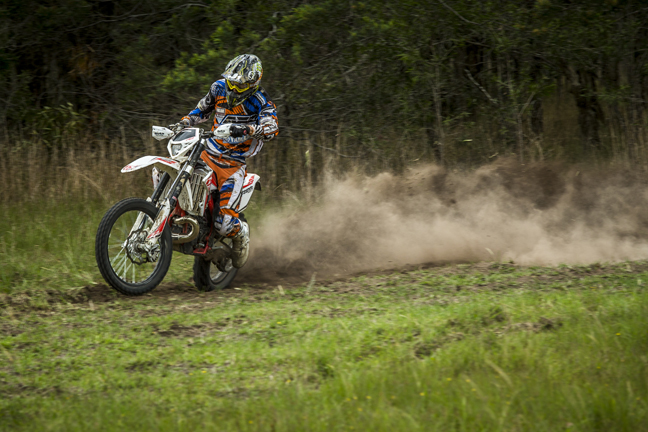
The Handling
The Sachs suspension really let the four-stroke Betas down last year. While both ends were plush over general trail obstacles, the fork had a tendency to deflect
off square-edge hits, and both ends fell through their stroke over big braking bumps and jump landings. Beta has persisted with Sachs, claiming the sweeping upgrades to the fork’s internals and completely overhauled shock absorber improve the suspension action markedly on the 2013 bikes.
True? Yes. The new fork rides higher in its stroke and doesn’t deflect anywhere near as much as last year’s, and both ends of the bike deliver a really compliant, stable and predictable ride in a majority of trail conditions. The Beta’s shock and linkage combine well with the linear power delivery on corner exits. The rear-end squats, hooks up and drives beautifully out of turns, even in slippery terrain. It’s more predictable than the KTM’s rear-end over choppy bumps, and puts the power to the ground so well, it gives you the confidence to keep the throttle pinned, even when the rear-end is already stepping out.
But the Sachs 48mm fork still dives big-time when you hit the picks hard, and when a fast rider starts to give the thing some stick, both ends still fall through their stroke and bottom-out too easily. The damping just doesn’t have the sort of progression we’ve come to expect from a cutting-edge enduro bike – which is what the Beta is in every other respect.
Once you’re past the braking zone and into the turn, the RR300 settles and feels very sure-footed, whether railing ruts or powering around fast sweepers. And in really tight terrain or ruts, where you’re using your inside leg to help control the bike’s arc, the lower and more compact dimensions of the Beta pays real dividends. And that mid-turn stability gives you the confidence to push harder than you ordinarily would. There’s no doubt the KTM’s WP fork and shock is sprung firmer and handles bigger hits much better. It still matches the Beta’s plush ride over the small trail chop and yet the action at both ends of the KTM is progressive enough to handle the big hits with much more composure. In other words, it’s a more versatile suspension package for riders of differing weights and abilities, and much less inclined to bottom out when it cops a big hit. With the triple clamp offset reduced to 20mm for 2013, the 300EXC isn’t quite as nimble to tip into a turn as its predecessor, but the bike’s front-end now has a more grounded feel through turns and better straight-line stability. Put simply, it gives you more feel for what the front tyre is up to at all times.

Is The Beta Better?
In many respects, yes. Which is a very big statement, given that this is Beta’s first two-stroke enduro bike. It’s got a fantastic engine, quality components and excellent ergos and brakes. The Betas have proved to be robust and they come with the same warranty as the KTM. And, critically, the RR300 is $700 cheaper than the 300EXC on dealer floors. For aggressive trailriders and racers, however, the Sachs suspension hasn’t kept pace with the competition and still lets the Beta down.
That’s likely to be a deal-breaker for some guys. But if you like the idea of standing out from the crowd, it’ll be easy to justify a decision to buy the Beta and spend the $700 ‘saving’ with a suspension tuner to get the Sachs fork and shock working a whole lot better. In any case, the combo of the Beta’s performance and pricing is enough to warrant it being on the radar for anyone interested in a 300cc two-stroke.
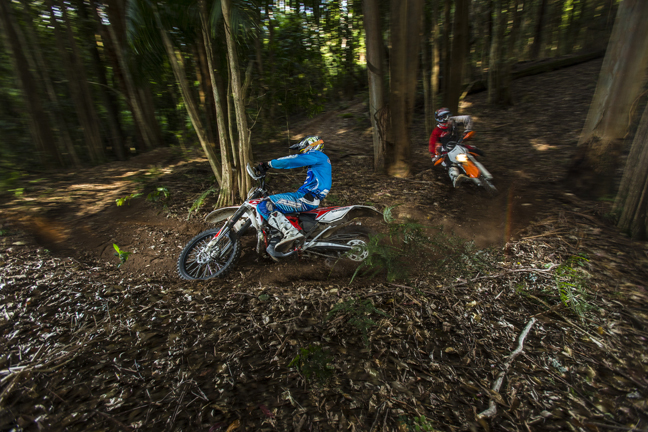
2013 Betas – What’s new?
Beta’s four-stroke models (RR350, 400, 450 and 498) get a bunch of upgrades for 2013, aimed mainly at reducing weight and improving the suspension. The all-new RR250 and 300 two-strokes also come with those improvements,and they share the four-strokes’ swingarm, wheels, brakes, bodywork and subframe. But the two-strokes do get their own frame geometry and suspension settings.
Shared Upgrades – 2T & 4T…
Chassis
- All frames get revised bracing – mainly around the steering head, upper shock mount and the junction of the steering head and twin cradle. The previous matte red frame paint is updated to gloss and all engine mount nuts are now captive.
- New wheels run lighter but more rigid hubs, lower-profile rims, new spokes, and different brake discs (with six mounting points). In total, the new wheels reduce weight by 1.5kg!
- The swingarm gets a revised profile and reduced wall thickness to improve rigidity and create better weight distribution. It’s 250g lighter and the previous all-alloy finish is now a combo of black and alloy.
- The polycarbonate subframe gets more cutaway sections to suit the all-new fuel tank. It’s lighter and improves access to the shock absorber.
- The 48mm Sachs USD fork gets a raft of upgrades to its internals that are claimed to offer better control for both low- and high-speed damping. The rebound adjustment is now tool-free – via star clickers in the fork caps.
- The Sachs shock absorberis totally overhauled for 2013. It now runs a larger reservoir to better resist overheating and fade, while the shock body is now alloy and 300g lighter. Plus mods to the subframe improve airflow to the new shock.
- The new fuel tank is designed to lower the C of G, plus improve both mobility in the saddle and airflow to the radiators. And the new fuel cap has an external thread for easier operation and to prevent dirt from falling into the fuel.
- The seat is narrower, shorter and flatter to suit the new fuel tank, and retains the quick-release button.
- The radiator shrouds get larger cutaways for better airflow to the radiators and engine. The radiator louvers are also redesigned to improve airflow.
- The new instrumentation is lighter, has an easier-to-read display, and indicators for lights and blinkers are now integrated.
- The rear tailguard extender is stiffened to carry a number plate more solidly.
- While the four-strokes retain the alloy skidplates, the two-stroke Betas get a hard-plastic unit.
- The updated graphics are designed to emphasise the slim ergos.
- Available in 250 and 300cc, the six-speed engines are designed, manufactured, assembled and tested in-house at Beta, with an overriding design philosophy that they produce easy-to-use, tractable power.
- The cylinder is specifically mounted at 90º to keep the engine compact and to shift the rotating mass closer to the bike’s C of G.
- Die-cast engine cases are used for reduced weight and added strength. They’re cast and machined entirely in-house to ensure quality and accuracy.
- Magnesium engine covers are fitted for weight savings and added strength.
- The two-piece crankshaft uses polyamide inserts to improve balance and to eliminate harmful ’empty volume’ in the crankcase.
- A forged two-ring piston is used to reduce rotating mass and increase durability, and the cylinder gets a Nikasil treatment.
- The cylinder comes with special resonator chambers to improve power delivery and throttle response at low revs. In effect, they generate added volume on the exhaust stroke for better low-rpm torque.
- The engines use a special adjustable power-valve system (BPV – Beta Progressive Valve). The design allows the main exhaust port to open progressively and independently from the two smaller, lateral ‘booster ports’. This is to create a broader powerband and no ‘holes’ in the torque curve. At high revs, the left-side booster closes the resonator to improve top-end performance. Like the KTM’s power-valve, the Beta’s BVP is altered via an external spring preload screw. But because adjustment on the Beta’s BVP system affects main and booster exhaust valves and the resonators, it’s arguablymore advanced than KTM’s.
- The electric starter is mounted under the engine to reduce C of G, and covered by a hard-plastic skidplate.
- To ensure reliability and performance, there’s a VForce4 induction reed, Keihin PWK 36mm carb, and Kokusan CDI and ignition.
- The exhaust system is a Beta-branded FMF – both the steel expansion chamber and the alloy silencer.
- Muffler internals are redesigned to meet the Phonometric FIM/2Metremax rules. The new muffler is lighter and claimed to create a smoother power curve.
- The air filter is redesigned to improve power at low revs. It comes with a new cage and bracket to ensure it mounts more securely.
- New DID O-ring chain for added durability.
- A claimed 4kg weight reduction for each model.
Suspension
Ergos
Two 300s – Toe to Toe
Powerplants
Widely regarded as the most user-friendly 300cc two-stroke enduro engine on the market, KTM’s 300EXC didn’t see any upgrades for 2013. The Beta RR300, on the other hand, is an all-new model with an entirely new engine. And unlike Beta’s four-strokes (which used KTM donks until four years ago), Beta’s two-stroke mill is very different to the KTM’s. The RR250/300 runs a 90º cylinder, die-cast engine cases with integrated electric starter, an ingenious power-valve system (which actuates main and booster ports, plus resonator chambers), magnesium engine covers and a full FMF exhaust system.
Shock Absorbers
KTM was happy with the performance of the WP shock absorber and the new frame that was introduced for 2012, so the settings in the 300EXC’s shock absorber remain unchanged for 2013. Plus it retains the handy plastic spring preload collar that prevents binding between steel and alloy collars. As the Beta’s Sachs shock suffered from overheating and fade in the hands of fast riders last year, it gets sweeping changes for 2013. The reservoir is now much bigger to resist overheating, and the shock body is now made from alloy and 300g lighter.
Fuel Tanks
The Beta’s fuel tank is completely new for 2013. It’s now mounted visibly lower relative to the steering head for a more streamlined junction with the seat and a lower C of G, plus the fuel cap now uses and external thread and lip to prevent dirt from making friends with the fuel. The Beta’s tanks are conveniently interchangeable across the 2013 two- and four-stroke models, but they’re still black and just 8 litres – that’s not a lot for a big-bore two-stroke. The KTM’s 9.5 litre tank retains a practical clear plastic construction.
Wheels & Brakes
For 2013, designers have managed to cut a whopping 1.5kg off the Beta’s wheels through upgrades to hubs, rims and spokes (à la what KTM did for their 2012 models via lighter double-butted spokes and high-grade alloy spoke nipples, which saved 400g). The only change for the KTM wheels this year is the move to a dark-grey anodised coating on the spokes to better resist corrosion. Both bikes run quality wave brake discs. The Betas get updated Nissin discs with six mounting points for 2013, while the Kato retains its Brembo braking package.
Airbox & Subframes
The two bikes use a similar airbox design and they work brilliantly. They’re both accessed via a snap-off airbox lid (without having to remove the seat) and there’s a spring-loaded retaining clip for the foam air filters. Like the KTM, the Beta uses the same air filter as its four-stroke cousins, but the shape of the Beta’s airbox and filter cage are specific to the two-strokes. The KTM’s subframe is a conventional alloy unit, while the Beta’s is polycarbonate. For 2013, it’s lighter and greatly improves access to the shock absorber.
Starter Motors
When KTM first introduced a starter motor to its 300EXC five years ago, it helped generate a resurgence of interest in two-strokes. But it’s also had some well-documented reliability issues and isn’t the most compact specimen. To keep weight low, Beta engineers fitted the RR250/300’s starter motor under the engine cases (which is what’s expected on the all-new Sherco and Jotagas two-strokes). And, unlike the often rattly KTM/Husaberg and Gas Gas starter motors, the Beta’s engages immediately every time and fires the bike to life in an instant.
Frames & Cockpits
KTM uses the same frame across its entire EXC range – two- and four-stroke. For 2013, the only change is that the 300EXC gets a reduction in the triple clamp offset (from 22 to 20mm) to put more weight over the front wheel.
The two-stroke Betas’ frame is derived from its four-stroke cousins, but it runs a steeper steering head angle and less cross-bracing to suit the two-strokes’ weight distribution. Both cockpits are minimalist but practical, and both use a similar Brembo hydraulic clutch and digital instrumentation. Nope, the Beta doesn’t come with handguards or bar pad as standard equipment.
Beta’s Two-Stroke Donk
The first of the new-generation two-stroke enduro engines from Beta are the result of 24 months of R&D. Here’s an insight into the new powerplant’s standout features:
Rider Feedback
Pro: Scott Keegan, 21, 78kg, 185cm
“Overall, I preferred the KTM, mainly because I ride them a lot and because the EXC’s suspension let me hit things aggressively without bottoming or upsetting the chassis balance. Plus, the KTMs have a proven track record and strong resale valve. That said, I loved the Beta’s ergos, power delivery and looks, but the thing’s Sachs fork and shock are holding it back from being more than a trailbike. The suspension is good up to a certain point, but fast guys will soon find its limits. Then again, the average trailrider probably won’t be slamming things hard enough to notice those shortcomings.”
Pro: Josh Green, 22, 80kg, 182cm
“I’d buy the Beta and spend $1000 on suspension. The bike’s ergos are great and its engine is awesome. With a more progressive and predictable fork and shock for the big hits, the RR300 would be hard to beat. The KTM does have more of a hit in the mid and that tends to make it feel faster, but in slippery or technical terrain, it can’t match the Beta’s torque and roll-on tractability. Also, lots of trailriders I know like to look different and, with so many guys on KTMs these days, the Beta definitely offers them that. And the Beta’s cheaper than the Kato.”
Vet/Pro: Damian Smith, 38, 67kg, 180cm
“The Beta’s got a great engine and the lower seat height makes it manageable in tight terrain. It’s got a high quality of finish and definitely gives you bang for your buck. The 2013 Sachs suspension is better but, like last year, it’s still letting the Beta down. For fast guys, it just doesn’t have the versatility that WP or Kayaba offer. As a racer, I’d pick the KTM over the Beta for its all-round capabilities and better suspension package, but the Beta is close to the mark. And that’s saying a lot for the brand’s first ever two-stroke enduro bike. With better suspension, the Beta two-stroke would be an absolute weapon.”
Vet/Clubman: Andy Wigan, 46, 90kg, 182cm
“The Beta factory clearly hasn’t just taken a punt with their new two-strokes. They’ve done their homework to produce unique machines whose performance is right there with the best on the market. Plus they’ve fitted a slick electric starter and priced the things very aggressively. The RR300 has benefitted from the weight saving mods made to the whole range for 2013, and in tight terrain, its superb ergos and user-friendly power made it the pick of the two for me. But the KTM’s chassis balance and suspension action gave me so much more confidence to attack bigger obstacles harder, and its engine remains a fantastic all-rounder.”
Vet/Clubman: Greg Smith, 42, 88kg, 182cm
“The KTM is a tried and tested machine with a really versatile engine and suspension package, quality components and good resale value. But you know what? I’d go for the Beta because I’m a trailrider, not a racer. Aside from its fantastic engine (which is easy to tune by adjustments to the power-valve), I found that the combination of the Beta’s chassis and lower seat height gave me the confidence to relax in the saddle, which meant I could ride the bike faster for longer. Though the first thing I’d do is put some work into the suspension, as it’s more suited to a beginner or intermediate-level rider.”
The 350cc Four-Strokes
Now that it’s 5kg lighter, how does Beta’s much upgraded RR350 fare against the KTM-inspired Husaberg FE350? We staged a 2013 re-match between the Italian and Austrian middleweights.
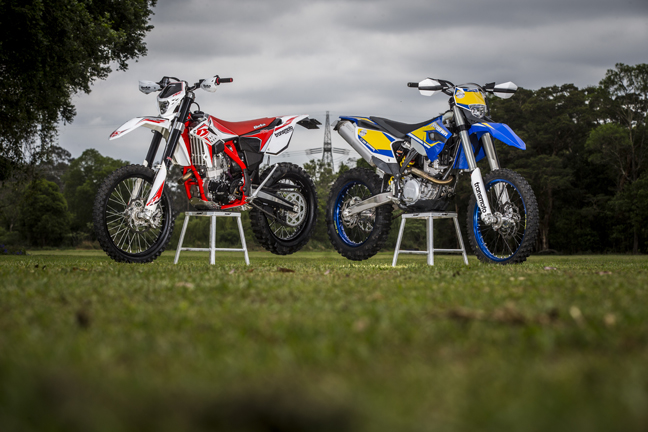
Twelve months ago, we compared Beta’s and KTM’s 350cc four-strokes. And in spite of all the hype surrounding the release of KTM’s all-new 350EXC-F back then, the Beta performed particularly well. The carb-fed Italian machine might have delivered a much different ride to the fuel-injected KTM, but the thing proved it had the engine, component spec and reliability to be a genuine contender in the class. It was $500 cheaper than the Kato, too.
However, at 121kg, the 2012 RR350 was 11kg heavier than the 350EXC-F. That’s a significant lump in a class that trades on power-to-weight figures and it placed added demands on the Beta’s Sachs suspension – which was fine for the trail, but no match for the Kato’s WP fork and shock for big hits.
So it’s comforting to note that Beta’s designers have now targeted those shortcomings. For 2013, they’ve managed to trim 5kg from RR350 and they’ve fitted it with an overhauled Sachs shock and fork. But have these upgrades paid dividends? Has the new RR350 closed to gap to the Austrian-made machine? And why did Beta stick with the Keihin carb rather than move to fuel injection? To put Beta’s 2013 RR350 in context, we spent a couple of days comparing it with our 2013 Husaberg FE350 long-term test bike – which, for all intents and purposes, is a 2012/13-model 350EXC-F.
The Ergos
As we found with Beta’s 2013 RR300, the lower seat and tank arrangement on the new RR350 makes the handlebars feel pretty tall. Most guys will want to roll the bars back a little to maintain a comfortable seated riding position, but the revised seat/bar/peg triangle definitely creates a lot more room under the bars for your inside leg when railing deep ruts. Aside from the Beta’s seat being a little lower and firmer than the Husaberg’s, the bikes’ cockpits don’t feel particularly different, though the pegs are a little lower and wider-set on the Beta. Controls on both machines are slick and precise, and you’ve got to award points to the Husaberg for having OTF adjustability on both brake and clutch levers, plus the fact it now runs rebound and compression star clickers in the
caps of the new WP 4CS fork.
The other difference that strikes you is now tall and bulky the Beta’s engine is in comparison to the super-compact Husaberg donk with its die-cast cases and diaphragm-spring clutch. Which makes sense, because the RR350 powerplant is an Beta-driven evolution of KTM’s older “RFS” engines, which house lots of gear driven components and a counter-balancer.
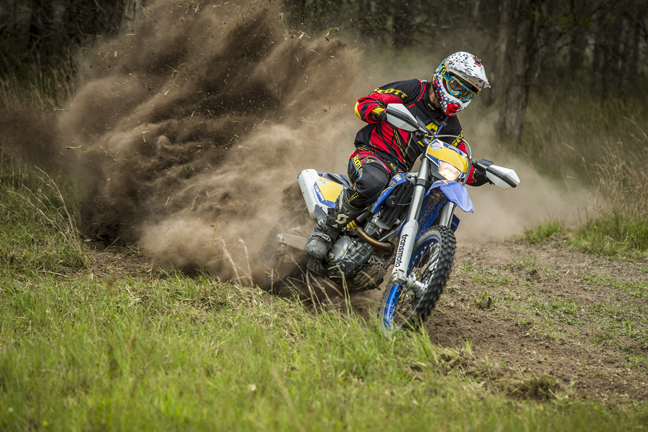
The Grunt
The Beta and Husaberg 350cc powerplants use the same bore and stroke, but you’d never guess it because the way they deliver their power couldn’t be any different. With our Beta and KTM 350cc comparo last year, we found that the Beta was more of a bottom-to-mid machine, while the KTM shone in the mid-to-top. And with no significant mods to either the Beta or Husaberg (ie, KTM) powerplants for 2013, the comparo between the 2013 bikes told a very similar story.
Even with the Keihin carb, the Beta’s powerplant has a refined and vibration-free feel with the bulk of its usable power delivered below 7500rpm. It’s got that old-school, torquey, linear, roll-on power that’s reminiscent of KTM’s hugely popular 400EXC. With noticeably more flywheel weight than the Husaberg, the Beta chugs effortlessly up hills and pulls smoothly out of low-speed turns. It’s a predictable, efficient and tractable sort of power, albeit not particularly exciting. Like the 350EXC-F (whose engine it shares), the FE350 is more of a mid-to-top screamer. It needs more clutch to get it into the meat of its power, but has a snappier, livelier personality with superb throttle response from its Keihin injection right through a very broad mid-range. And because it keeps pulling for what feels like 2000-3000rpm further than the Beta, it allows you to hold gears and save upshifts between turns.Despite all those difference, there’s barely a bike-length between the two bikes when you drag race them through the gears on the open road.
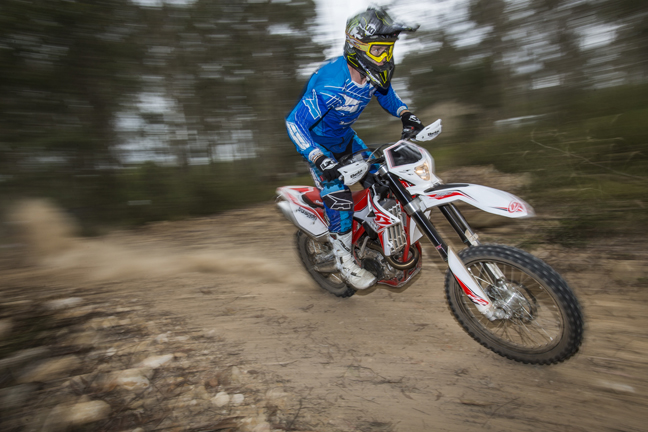
The Handling
The FE350’s WP suspension is very plush on the trail, and for a bike that weighs just 110kg, it resists getting bounced off-course incredibly well. But when you start to give things a nudge, you soon realise that the Husaberg’s suspension settings are more trail-oriented than those found on its 350EXC-F ‘cousin’, particularly the new 4CS (4 Chamber System) fork. The 2013 Berg uses most of its suspension stroke for moderate-sized bumps, and tends to wallow when you attack fast sweepers, which upsets the chassis balance and your confidence to hold a tight line. And on high-speed hits or a series braking bumps, it’ll bottom-out pretty easily. Most 85kg trailriders will look to fit firmer spring rates at both ends, or at least in the fork. On snotty trail, the Beta’s upgraded Sachs suspension is similarly impressive, despite the fact it’s sprung noticeably firmer than the RR300 we tested in the same terrain. The RR350 is even more stable and sure-footed than the Husaberg over rocks and choppy ground, especially at speed; almost as if the Beta is the beneficiary of a longer wheelbase. The new Sachs fork runs the same 0.48kg/mm springs as last year’s bike, but the revised valving has definitely given it a lot more control over bigger hits. Gone is its tendency to deflect off square-edged bumps, and because the fork sits up in its stroke better, it gives you the confidence to drive the 2013 bike harder into turns. Married with matching improvements in the shock absorber, the RR350 chassis balance is now noticeably better. When compared to the Berg, the Beta requires a bit more effort to crank into a turn, but it settles nicely in the mid-turn and allows you to draw smooth, controlled lines.
Yes, the Sachs suspension package has come a long way since last year, and it works much better than Beta’s lightly sprung two-strokes. The 5kg weight saving does make the new RR350 more agile in the tight stuff, but compared with the Husaberg, it’s still harder to change direction quickly. We reckon this is less about the bikes’ relative curb weight, and more to do with the fact that Husaberg’s super-compact new engine has much less reciprocating mass and minimal affect on handling.
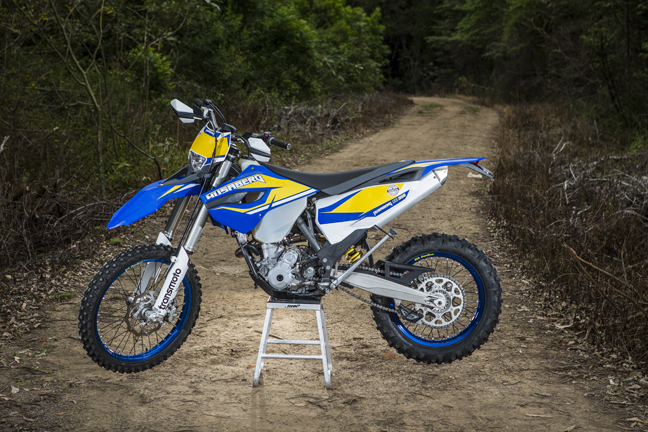
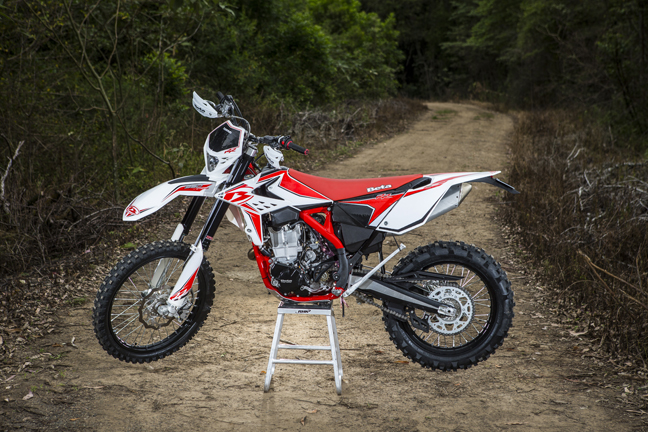
Beta’s Four-Stroke Updates
In addition to the upgrades it shares with the new two-stroke models, Beta’s 2013 four-strokes (which are spearheaded by the RR350) also get the following:
No EFI?
The fact that Beta elected to stay with the 39mm Keihin carburetor instead of moving to an EFI system (like all its major competitors) won’t upset everyone – for the simple reason that fuel injection is still far from being universally embraced by trailriders. Or enduro riders, for that matter. Our take is that Beta’s decision was as much about cost and weight considerations as it was about perceived reliability. An EFI system typically adds 2-3kg to a bike, so introducing it for 2013 would have flown in the face of the designer’s obsession with saving weight. Sticking with the carb also saved Beta from the enormous expense of developing mapping for their four-stroke models (KTM says each model’s mapping takes one EFI expert more than three months to get right!).But can Beta hold out on EFI forever? We very much doubt it. In fact, this scenario is very reminiscent of KTM in 2011, when they held off on embracing EFI until they had a purpose-built enduro engine to fit it to (the following year). Yep, there might just be an all-new fuel-injected Beta engine around the corner!
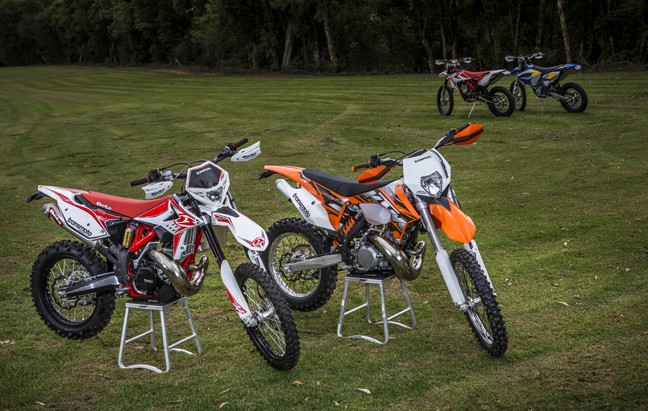



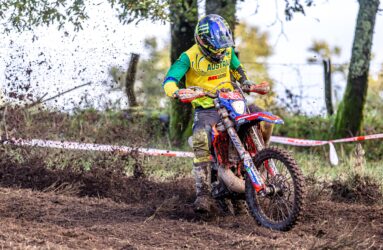



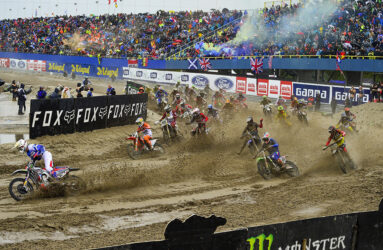
Be the first to comment...